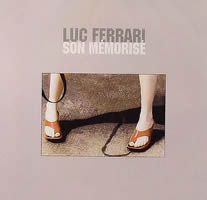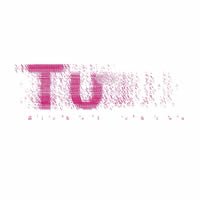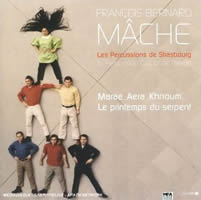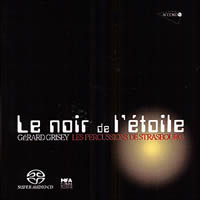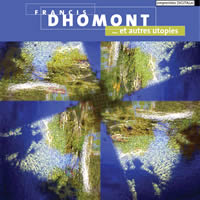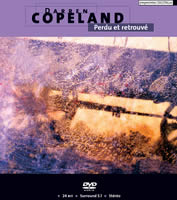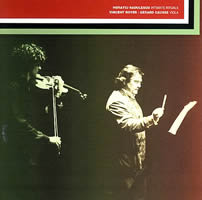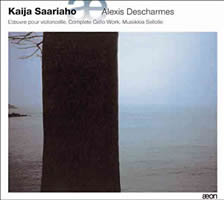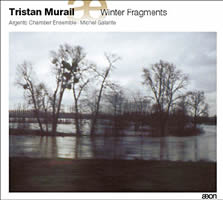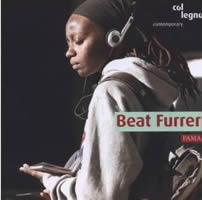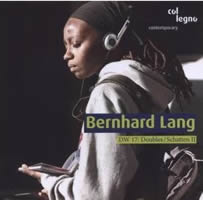EA Bucket 7: Working Masters
|
Grant Chu Covell [September 2007.] In the third part of a closely spaced series which began here and continued here, I look at some of today’s best composers using electronics, whether purely electroacoustic or incorporating instruments. It’s completely unintentional that most are European, that several stand beneath the spectralist umbrella (Grisey, Murail, Radulescu and Saariaho), and that compared with the two earlier installments, none are US natives (however, Murail now resides in NYC).
“Son Mémorisé.” Luc FERRARI: Presque Rien #4, “La remontée du village” (1990-98); Promenade Symphonique dans un paysage musical ou Un jour de fête à El-Oued en 1976 (1976-78); Saliceburry Cocktail (2002). Sub Rosa SR252 (http://www.subrosa.net/). Distributed in the US by Forced Exposure (http://www.forcedexposure.com/). Michel CHION: Tu (1977-96, ver. 2006). Brocoli 002 (http://www.brocoli.org/). Distributed in the US by Ear / Rational (http://www.ear-rational.com/). The middle release in a Sub Rosa trio contains three Ferrari works defying simple explanation. Attentive auditing suggests themes, relationships and an ambivalent guiding hand. Casual inspection is impossible; these pieces suck you into a maelstrom of possible interpretations. With Ferrari, it’s always hard to separate pristine field recordings from studio hijinks. In his fourth and final “Almost Nothing,” Mr. & Mrs. Ferrari meander through an “old Vintimille village” (presumably the town of Vintimille itself, inadvertently obscured in translation). Sounds captured along the way include motorbikes, children, voices raised in greeting and a TV heard from the street. Silences follow eruptions. Ferrari effortlessly blurs private and public. The Presque Rien series concludes with “Ciao.” An audio-montage, Promenade Symphonique elegantly captures a vibrant wedding day in the Algerian desert. The last piece, Saliceburry Cocktail, a grand symphony of obfuscation and buried treasure, churns drumbeats, women breathing, stolen glances and recycled materials. “I took old items and, since I didn’t want to hear some of them, I hid them under other items I also didn’t want to hear.” Chion’s awesome Tu, a “mélodrame concret” in two acts, explores Mozart / Schikaneder’s Magic Flute by way of Robert Desnos’ Flûte Enchantée. Sixteen voices including the composer’s deliver the near-incessant French and German texts. An hour long, this is one of the most insidious and disturbing compositions I have ever heard, reaching maximum intensity deep into the second act with Tu me suicides. Here and there a piano emerges, or Tamino’s flute, but for the most part, Chion skillfully shrouds the theatrical recitations, adding predominantly unfamiliar rumblings and shrieks intended to confuse, terrify or disgust. Additionally, we hear concrète music’s mechanics, such as studio noises and the whirr of tape speeding up. Brocoli’s enormously impractical packaging folds an unprotected CD into beige cardboard printed faintly in small red type. The libretto is similarly rendered on an eight-panel strip of tracing paper, impossible to read without strong light and solid backing. Despite all these inconveniences and Tu’s rawness, you’ll have to pry this one out of my hands.
François-Bernard MÂCHE: Maraé (1974); Aera (1978); Khnoum (1990); Le printemps du serpent (2001). Les Percussions de Strasbourg: Jean-Paul Bernard, Claude Ferrier, Bernard Lesage, Keiko Nakamura, François Papirer, Olaf Tzschoppe; Ju Percussion Groupe de Taiwan: Shih-San Wu, Hong-Chi Ho, Pei-Ching Wu, Kuen-Yean Hwang, Heui-Chen Wu, Chia-Hao Hsieh. Accord 476 8038. (I found my copy in Canada at Archambault [http://www.archambault.ca/].) Gérard GRISEY: Le Noir de l’Étoile (1989-1990). Les Percussions de Strasbourg: Jean-Paul Bernard, Claude Ferrier, Bernard Lesage, Keiko Nakamura, François Papirer, Olaf Tzschoppe. Accord 476 1052, SACD format. Distributed in the US by Premiere Music Distributors (http://www.premieremusic.net/). Folks expecting crashing cymbals and pounding drums will be surprised. Certainly Les Percussions de Strasbourg can deliver bravado. Here they demonstrate their considerable skills at subtlety. Mâche’s demanding scores can require precise synchronization with tape, as in Maraé and Le printemps du serpent. Alongside his musical career, Mâche has studied archaeology and taught ancient art and classical literature. Like Xenakis, Mâche’s music is infused with Hellenic culture. And like Aperghis, Mâche has worked at separating speech from language. Maraé, akin to “place of worship” in Polynesian and suggesting “the sea” in French, requires non-pitched percussion alongside pre-recorded wind, water and fire sounds. The 17:20 work entrances, whether interpreted as ritual or journey, or even as a parcel of curious noises. Writing about Aera for percussion ensemble (no tape), Mâche says: “If the word ‘clairvoyance’ had an equivalent in the sphere of sound, one might say it was that which I sought to awaken.” The six players frolic with instruments of definite pitch, the gently unfolding harmonies suggesting an etude or a minimalist’s pattern book. Blurring the lines between keyboard and five percussionists, Khnoum calls for a synthesizer (“échantillonneur”) containing samples of the percussion battery. The tour de force Le printemps du serpent calls for 12 percussionists and tape, and requires its executants to mimic animal sounds and rain noises. Thwarting expectations, the work is neither cute nor an excuse for a dozen drummers to run riot. Pairing percussion with pulsars, Le Noir de l’Étoile is a tad difficult to penetrate, which is what we should expect from such as Grisey. Astrophysicist Jean-Pierre Luminet recites for this SACD’s first track. The booklet prints a different Luminet text under the heading, “[t]he sky is a space of noise, rhythm and violence.” Pulsars and percussion appear as a single kaleidoscope’s opposing ends. The score requires the six players to surround the audience, and in addition to the pre-recorded tape there should be live signal transmissions as well. Xenakis’ Persephassa (whose six percussionists encircle the audience) seems the precedent, especially at the second movement’s conclusion; however, Grisey favors powerful splattering gestures and atmospheric colors instead of driving rhythms. The opening 22:07 first movement’s build is tremendous, and the third movement’s climax is awesome. While it’s clear where percussion ends and pulsars begin, their overlapping moments beg deciphering the random beats from space and perceiving the man-made sounds as organic entities. Le Noir de l’Étoile was recorded live before a greatly appreciative audience. Play it loud, at night and in the dark.
“… et autres utopies.” Francis DHOMONT: Here and There (2003); Je te salue, vieil océan! (1998, 2000-04); Chroniques de la lumière (1989, 2005); Voyage-miroir (2004); Corps et âme (2001-02). empreintes DIGITALes IMED 0682 (http://empreintesdigitales.com/). Distributed by electrocd.com (http://www.electrocd.com/). “Perdu et retrouvé.” Darren COPELAND: They’re Trying to Save Themselves (2002); Streams of Whispers (2002); The Wrong Mistakes (2003); On Schedule (2003); Early Signals (2001); On a Strange Road (2003); Faith-Annihia (1991); Always Becoming Somebody Else (1991-92). empreintes DIGITALes IMED 0683, DVD-A format (http://empreintesdigitales.com/). Distributed by electrocd.com (http://www.electrocd.com/). An acknowledged master — every piece here was commissioned and / or received an international award — Dhomont’s bright new empreintes DIGITALes release groups “five fantasies to be listened to with eyes closed.” It’s a mesmerizing ride. The manically voluble Here and There explores spatialization with predominantly synthesized material. Je te salue, vieil océan! folds in excerpts from Lautréamont’s The Songs of Maldoror read by Marc-Henri Boisse (in French). The few real-world sounds are immediately transformed: Chroniques de la lumière’s central movement, Artifices, concerns itself with man-made light sources, quickly dissolving a struck match’s snap and fireworks’ eruption. Transformed chorus and crowds rush through Corps et âme. Dhomont routinely applies an army of studio techniques, filtering, speed changes, but foremost, he delivers rich color and impenetrable variety. Its notes referencing departure, fleeing, exile, life and death, the most recent item, Voyage-miroir, haunts imposingly. These decidedly oneiric pieces shine. Not for the faint of heart. Glorious concrète asserts itself on Copeland’s newest eD disc, where animal noises, trains and other semi-recognizable sources color the mysteries. Copeland tends towards the industrial, as in Faith-Annihia’s attempt to “create a sonic equivalent to the experimental film notion of ‘flicker,’” whose ambience and collaged trains suggest Schaeffer’s first etudes. They’re Trying to Save Themselves and Streams of Whispers work with recorded speech, the latter an extended rhapsody on its title’s syllables, the former a less successful exploration of an eyewitness account of the 9/11 attacks. The Wrong Mistakes subverts the composer’s routine methods, attempting to legitimize choices he would ordinarily reject. On Schedule manipulates locomotive noises according to 27 preset transformations derived from the route between London’s Waterloo and Moscow’s Belorusski stations. Early Signals commemorates radio pioneers Marconi and Eckersly, and On a Strange Road unites car travel with a metaphysical journey. In Always Becoming Somebody Else, a jungle exploration stumbles across another planet. These pieces enthrall with their fine details, and as ever, empreintes DIGITALes issues gorgeous productions.
“Twittering Machine.” Rytis MAZULIS: Twittering Machine (1984-86); Ex Una Voce (2004); Clavier of Pure Reason (1992-94); Hanon Virtualis (2002). Megadisc MDC 7809 (http://www.megadisc.be/). Distributed in the US by Forte Distribution (http://www.fortedistribution.com/). “Intimate Rituals.” Horatiu RADULESCU: Das Andere, Op. 49 (1984); Agnus Dei, Op. 84 (1991); Lux Animae II, Op. 97β (1996/2000); Intimate Rituals XI, Op. 63ψ (2003). Vincent Royer, Gérard Caussé (vlas), Petra Junken, Horatiu Radulescu (sound icon). Sub Rosa SR 248 (http://www.subrosa.net/). Distributed in the US by Forced Exposure (http://www.forcedexposure.com/). An adrenalin shot in CD form, this glorious Megadisc release has yet to achieve celebrity despite its enormous appeal. Mazulis’ energized computerized piano music proclaims a wry minimalist stance: Glass’ aesthetic pushed to outrageous extremes. The pieces build and swell, as if an ascending balloon’s expanding horizon. Twittering Machine works magic with interlocking triads and a saloon-piano gesture, a thousand smiling Nancarrows in synchronized swimming. Despite the overt repetition and presto pace, it’s impossible not to feel an emotional tug at recurring cadences. In Ex Una Voce I imagine 100 pianos playing in canon with lockstep rhythms — soldiers executing parade-day drills. Clavier of Pure Reason spreads like a plague: single wisps, an upwards glissando, a catchy tonal nip may audibly escape the deafening churning. Wittily titled, Hanon Virtualis suggests vacuous 10-finger etudes pumped with steroids. The pitched lines soon meld into thunderous hammers, a noise cloud swallowing all pitch sense. Have you ever wondered what all 88 keys sound like struck at once? A potential room clearer perhaps. My guess is, you’ll hunger for more. Of these four Radulescu viola pieces, just one embeds a pre-recorded element. Intimate Rituals XI’s tape could be performed live, but here it is a delicate 1986 improvisation employing Radulescu’s proprietary sound icons, essentially grand pianos sitting vertically with 24 identically tuned strings made to vibrate with “tangent spheres” (I imagine tennis balls). Viola and sound icons are tuned to the same fundamental forming a reassuring spectral bath through which the viola leaps and dives. Das Andere and Lux Animae II require a solo violist who must cavort through precise mazes of partials and Fibonacci-derived durations, common Radulescu playgrounds. Royer performs this demanding music with agility. Some special bowing creates a frail rasping. A Stravinsky homage, Agnus Dei for viola duo is perhaps the most conventional, the hocketing violas cycling through intriguing pitch patterns. With their talk of tuning and mysticism, the program notes may confound. Never mind that. Royer and Caussé give great voice to this entrancing music.
“Complete Cello Works.” Kaija SAARIAHO: Petals (1988); Oi Kuu (1990); Spins and Spells (1997); Mirrors (1997); Sept Papillons (2000); Près (1992). Alexis Descharmes (vlc), Jérémie Fèvre (fl), Nicolas Baldeyrou (bclar), David Poissonnier (electronics). Aeon 0637 (http://www.aeon.fr/). Distributed in the US by Harmonia Mundi (http://www.harmoniamundi.com/). “Winter Fragments.” Tristan MURAIL: Winter Fragments (2000); Unanswered Questions (1995); Ethers (1978); Feuilles à travers les cloches (1998); Le Lac (2001). Argento Chamber Ensemble, Michel Galante (cond.); Erin Lesser (fl). Aeon 0746 (http://www.aeon.fr/). Distributed in the US by Harmonia Mundi (http://www.harmoniamundi.com/). Bookending Descharmes’ Saariaho recital, Petals and Près combine cello with subtle electronic enhancement. Petals’ processing adds a burr to the scraping, nasal cello. Three-movement Près is more poetic and symphonic, but not what you’d call pretty. With Saariaho, I’ve come to expect entrancing colors blended with hard-edged severity. Oi Kuu combines bass clarinet and cello into one instrument. Mirrors and Spins and Spells are brief jaunts, though the arch Mirrors with delicately intoned flute syllables could have conceivably flourished more. Descharmes spins a rich tone, especially in the harmonics and guttural rasps Saariaho favors. You hear this to great effect in Sept Papillons which alternates between feathery Bachian arpeggios and aggressive grinding. On this Murail program, nature looms as a hulking influence for these five elegantly transfixing works. Only the spellbinding Winter Fragments contains electronics. However, among Le Lac’s gossamer spectrally derived chords and the delicate quartet Feuilles à travers les cloches’ exquisitely instrumented harmonic effects, Murail’s technical affinity emerges. He did after all master the ondes Martinot in several of his teacher Messiaen’s compositions. Winter Fragments lives far from Robert Frost’s peaceful snow falling on stone walls. Scored for flute, clarinet, piano, violin, cello and electronics, this composition resides in an icy, desolate place, severe and cruel. Unanswered Questions is a brief solo flute piece. Ethers for flute and small ensemble (trombone, percussion, violin, viola, cello and bass) recalls a nasal sho. Two maracas rattling almost continuously provide a light haze from which the flute (doubling alto, bass and piccolo) and grainy strings slice upwards. A brief moment past the middle, threatening to break into a tin-pan-alley song, gathers momentum and hurls into a devestating climax.
“Donaueschinger Musiktage 2005, Vol. 1.” Beat FURRER: FAMA (2005). Neue Vocalsolisten Stuttgart; Eva Furrer (contrabass-fl); Bernhard Zachhuber, Manfred Spitaler (bclars); Isabelle Menke (actress); Klangforum Wien, Beat Furrer (cond.). col legno WWE 1SACD 20612, SACD format (http://www.col-legno.com/). Distributed in the US by Qualiton (http://www.qualiton.com/). “Donaueschinger Musiktage 2005, Vol. 2.” Bernhard LANG: DW 17: Doubles / Schatten II (2004). Dimitrios Polisoidis (e-vla), Michael Moses (e-vlc), Experimentalstudio der Heinrich-Strobel-Stiftung des SWR, Freiburg: Michael Acker, Thomas Hummel, Roland Breitenfeld (eng.), SWR Sinfonieorchester Baden-Baden und Freiburg, Sylvain Cambreling (cond.). col legno WWE 1SACD 20613, SACD format (http://www.col-legno.com/). Distributed in the US by Qualiton (http://www.qualiton.com/). Site-specific FAMA, “audio theatre piece for large ensemble, eight voices, actress, and sound structure,” requires the best performers for execution. Luckily, Furrer draws upon the talented Neue Vocalsolisten Stuttgart and Klangforum Wien. Also credited are the architect, acoustician, technical and lighting engineer, costumer and stage direction. Texts are by Ovid and Arthur Schnitzler. The focus on space and solo instruments (contrabass flute and two bass clarinets) suggest Nono’s late aesthetic. I might have confused this with Sciarrino if it weren’t for the German vocals. This eight-section composition is vibrant but less blustery than other Furrer works. Instruments cast their sounds in specified directions. The performance space includes walls with rotating shutters faced with metal or plastic so that different reflective qualities can be achieved. As the sounds on the disc change subtly, I imagine that the live experience must have been fascinating, especially in the seventh section with chorus and swirling instrumental lines. (To judge from their website, Kairos 0012562KAI offers an identical release.) I had been eagerly looking forward to Lang’s DW 17, having elsewhere enjoyed his aesthetic’s outcome. In an homage to British guitartist Justin Broadrick, electric viola and electric cello are surrounded by an orchestra which includes synthesizers, electric guitars and real-time electronic manipulation. Phrase repetitions occur constantly, with some long sentences disguising their duplication. Frenzied rock-concert solidities alternate with tissue-thin atmospheres. The razzing, whining solo instruments provide a frailty as well as an indication that not all repetitions are identical, despite the supporting orchestra’s oiled precision. The DW series’ 17th installment marks a definite maturation, revealing subtlety and luxuriant sound strata. Imagine Godzilla chewing its way through downtown Tokyo. Lang has a brilliant feel for color and structure. Where else could these pieces occur but under the Donaueschinger umbrella? As always, col legno’s sound and documentation are impeccable. I especially like how the covers, drawn from the festival’s poster, mimic Vermeer.
B Lang, Chion, Copeland, Dhomont, Ferrari, Furrer, Grisey, Mâche, Mazulis, Murail, Radulescu, Saariaho
[More EA Bucket, Grant Chu Covell]
[More
B Lang, Chion, Copeland, Dhomont, Ferrari, Furrer, Grisey, Mâche, Mazulis, Murail, Radulescu, Saariaho]
[Previous Article:
Words Fail Me 4.]
[Next Article:
Words Fail Me 5.]
|
